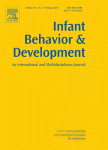
与你的心跳保持同步并不总是一件容易事儿。但对于人类婴儿和他们的母亲来说,同步彼此的心跳却像分享一个微笑般简单。
一项新的研究表明,3个月大的婴儿能够和他们的妈妈在几毫秒的时间里使彼此的心跳同步。
研究人员让40对母婴面对面相处,并在每个人的心脏部位配备了能够黏在皮肤上的电极。
一下接一下,随着他们分享充满爱意的面容或是欢乐的笑声,母亲与孩子的心跳几乎立即便融为了一体。
以色列希伯来大学的Ruth Feldman和同事在2011年12月出版的《婴儿行为与发育》杂志上报告说,这种心脏耦合工作的情况仅仅适用于母亲和她们自己的宝宝,并且只有在两人同步微笑以及进行其他快乐的社会行为时才会出现。
研究人员推测,当人类反射其他人的面部表情时,他们或许开启了大脑中的特定区域,进而告知心脏何时脉动。
然而,母亲融合的心跳持续的时间更长,而非仅仅几下心跳。
根据来自同一实验室的前期工作,那些无法与妈妈协调一致的婴儿在青春期较少发生移情作用。
早产儿或那些妈妈罹患产后抑郁症的婴儿最有可能丧失这种社会技能,因为他们错失了与母亲相互交流的早期机会。

Mother and infant coordinate heart rhythms through episodes of interaction synchrony
Ruth Feldman, , Romi Magori-Cohen, Giora Galili, Magi Singer, Yoram Louzoun
Animal studies demonstrated the powerful impact of maternal-infant social contact on the infant's physiological systems, yet the online effects of social interactions on the human infant's physiology remain poorly understood. Mothers and their 3-month old infants were observed during face-to-face interactions while cardiac output was collected from mother and child. Micro-analysis of the partners’ behavior marked episodes of gaze, affect, and vocal synchrony. Time-series analysis showed that mother and infant coordinate heart rhythms within lags of less than 1 s. Bootstrapping analysis indicated that the concordance between maternal and infant biological rhythms increased significantly during episodes of affect and vocal synchrony compared to non-synchronous moments. Humans, like other mammals, can impact the physiological processes of the attachment partner through the coordination of visuo-affective social signals.
文献链接:https://www.sciencedirect.com/science/article/pii/S0163638311000749








